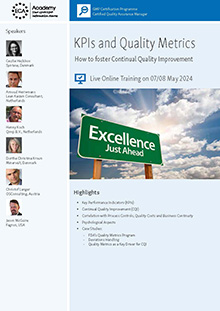New Annex 1: Consequences for the QP

Recommendation
7/8 May 2024
How to foster Continual Quality Improvement
On December 20, the long-awaited draft of Annex 1 was published (Manufacture of Sterile Medicinal Products). The special feature here is that the revised Annex 1 will not be an independent EU document but should also apply directly to the PIC/S guidelines. So the planned revision will replace the current versions of EU-GMP Annex 1 and the PIC /S document PE 009 -11 "Manufacture of sterile Medicinal Products". This is why the draft does not contain any direct references to the term "Qualified Person" (QP); the QP is called here "Person responsible for the quality release of sterile medicines".
In general, the document will be much more extensive and contain some new rules and additions. There are also some things to consider for QPs:
It doesn't really come as a surprise that this so called responsible person should have "appropriate access to manufacturing and quality information and possess adequate knowledge and experience in the manufacture of sterile dosage forms and their critical quality attributes."
But also a few things which need to be considered in the batch certification process are described directly:
- Where used for aseptic manufacturing, confirmation of the integrity of the final sterilization gas filter should be considered as part of the batch release process [7.19].
- Sterilization records should be available for each sterilisation run. These should be reviewed and approved as part of the batch release procedure [8.40].
Batch release within the Contamination Control Strategy
According to Annex 1, the environmental and process monitoring program should be part of an overall contamination control strategy (CCS). The goal is to minimise the risk of both microbial and particulate contamination. Here, the information from the CCS systems should be "used for routine batch release and for periodic assessment during process review or investigations" [9.3].
Results from monitoring surfaces and personnel and environmental monitoring data generated in grade A and B should also be considered during batch record review [9.11], [10.10].
In those cases where Parametric Release is performed (and has been authorised), the following should also be considered:
- A robust system should be applied to the product lifecycle validation and the routine monitoring of the manufacturing process. This system should be periodically reviewed [8.48].
- If a sterilization with ethylene oxide is performed (which should only be used when no other method is practicable), each sterilization cycle should be monitored with suitable biological indicators, using the appropriate number of test pieces distributed throughout the load unless parametric release has been authorized by the National Competent Authority [8.75].
- The bioburden assay should be performed on each batch and considered as an in-process test. Where appropriate, the level of endotoxins should be monitored [10.4].
Related GMP News
GMP Conferences by Topics
- General Quality Assurance and GMP Compliance Topics
- Hygiene
- General Microbiology Topics
- Regulatory Affairs
- Development
- General Analytics Topics
- Good Distribution Practice
- Sterile Manufacturing
- Computer Validation
- General Qualification/Validation Topics
- General Engineering Topics
- APIs/Excipients
- GMP Basic Training Courses
- Medical Devices and Combination Products
- Packaging and Packaging Material
- Data Integrity
- Qualified Person (QP)
- GMP Auditing
- Documentation
- Cleaning Validation
- General IT Compliance Topics
- Impurities
- OOS / OOE / OOT
- Material Testing
- Validation of Analytical Methods
- Analytical Instrument Qualification
- Stability Testing
- Microbiological Testing
- Technology
- General Manufacturing Topics
- Solid Dosage Forms/Semi-Solid Dosage Forms
- Biotechnology/Blood/ATMP
- Herbal Drug Products/Cannabis/Radiopharmaceuticals
- Others




